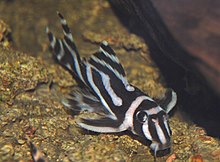Clearwater river (river type)
This classification system was first proposed by Alfred Russel Wallace in 1853 based on water colour, but the types were more clearly defined according to chemistry and physics by Harald Sioli [de] from the 1950s to the 1980s.
[2][8][9] Although many Amazonian rivers fall clearly into one of these categories, others show a mix of characteristics and may vary depending on season and flood levels.
[12] Examples of clearwater rivers originating in the Guiana Shield include the upper Orinoco (above the inflow of the blackwater Atabapo and whitewater Inírida–Guaviare), Ventuari, Nhamundá, Trombetas, Paru, Araguari and Suriname.
[7] In South America, clearwater rivers typically have their source and flow through regions with sandy soils and crystalline rocks.
[8] The exact chemistry of clearwater rivers varies,[8] but it is often very similar to rainwater, low in major nutrients with sodium as the relatively dominating chemical.
[8][22] There are major differences in the amount of macrophytes and this is mainly related to light: heavily shaded clearwater rivers have few, while those flowing through more open regions often contain many.




